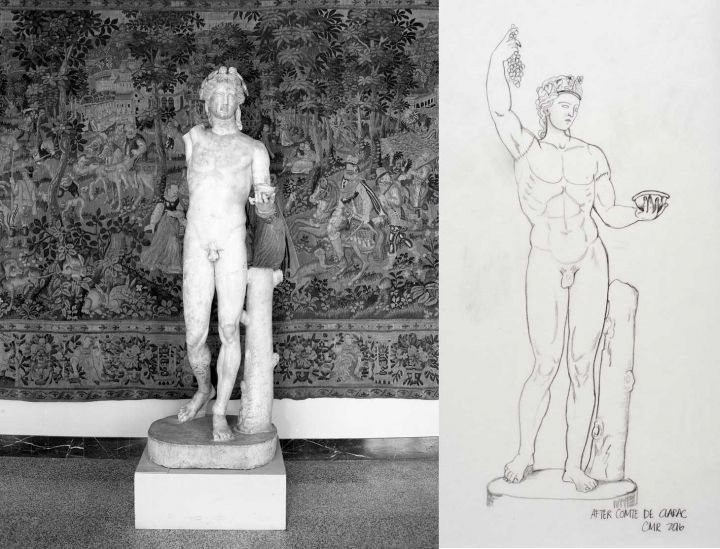College Basketball Player Lends a Limb to Armless Roman Statue
The 6-foot-9 forward for North Carolina State University posed for a 3-D reconstruction of the sculpture’s missing arm
/https://tf-cmsv2-smithsonianmag-media.s3.amazonaws.com/filer/2b/63/2b63b786-ea04-4644-9e86-0080fffbdd7d/di25744-34-720x480.jpg)
The North Carolina Museum of Art’s statue of Roman wine god Bacchus is, essentially, the patchwork doll of classical sculpture. Boasting a 2nd-century Roman torso, a borrowed head corresponding to roughly the same time period, and limbs, hair locks, berries and leaves added during the late 16th or early 17th century, the striking 6-foot-8 work is missing just one body part: his right arm.
Luckily, a 6-foot-9 North Carolina State University basketball player was willing to lend the statue a limb—figuratively speaking, of course. As Sarah Rose Sharp reports for Hyperallergic, museum conservators recently approached graduate student Wyatt Walker, who plays forward for the team, with an unusual request: Would he model for a 3-D reconstruction of the sculpture’s missing arm?
Walker, whose height and athletic build closely mirror that of the marbled Bacchus, agreed. Drawing on an 1837 drawing of the complete sculpture, staffers had him mimic the sketched statue’s stance—right arm held high, fingers laced around a cluster of grapes—and pose for a 3-D scan. Local artist Larry Heyda of Lawrence Heyda Studios will now use those scans to restore the Bacchus statue to its full former glory, according to a press release.

Walker’s modeling session is the latest development in the museum’s ongoing Bacchus Conservation Project. Artnet News’ Caroline Goldstein reports that the initiative, launched in 2013, builds on scholars’ 1960s discovery of the sculpture’s makeshift nature. This latest burst of activity has found staffers shifting gears from “complete derestoration”—efforts to disassemble the work and display each fragment separately—to "re-restoration." (The derestoration push, incidentally, is actually why Bacchaus’ head is not currently attached; the project portal notes that it was removed back in the mid-1980s, with the berries, leaves and locks of hair adorning the bust following in 1990.) The team's shift in philosophy arrives as recent research reveals that the statue contains more fragments from ancient quarries than previously thought, building a case for displaying the work as a cohesive unit.
The core draw of the statue is, of course, its Roman torso, which extends roughly from the top of the chest to the upper thighs, according to the project’s website. Sometime during the late 16th or early 17th century, an unknown party crafted new legs, arms and embellishments to complement the ancient mid-section, shamelessly plucking the head off of a 1st- through 3rd-century Roman marble of Dionysus, Bacchus’ Greek counterpart, to complete the sculpture. The wine god remained in this Frankenstein's monster-like state until the mid- to late-1940s, when he lost his arm under unknown circumstances.
Bacchus 3.0, if you will, not only includes the 3-D mold of the statue’s missing arm—reversible in case future researchers decide to detach it—but also the bust’s extant head and miscellaneous adornments.
The restored statue’s debut will be accompanied by a catalogue detailing its rich history, which now stretches nearly 2,000 years, and an exhibition featuring behind-the-scenes interactives exploring its lengthy conservation process.
While Walker joins the rare few who can brag about being an (arm) model for a Greek god, he remains humble about the opportunity: “It was a privilege to be chosen to help with this project,” he says in the release. “... I was honored to be able to offer my arm for 3-D scanning.”
/https://tf-cmsv2-smithsonianmag-media.s3.amazonaws.com/accounts/headshot/mellon.png)


/https://tf-cmsv2-smithsonianmag-media.s3.amazonaws.com/accounts/headshot/mellon.png)